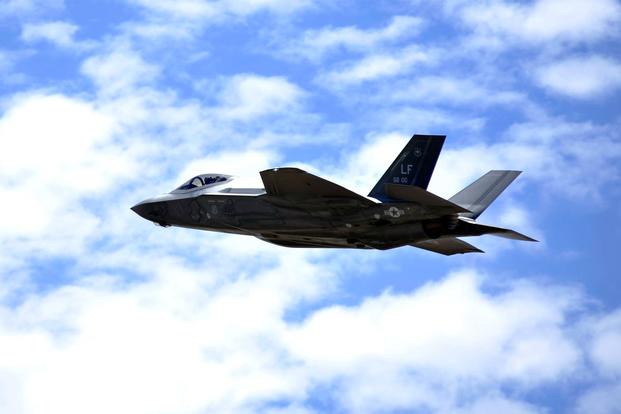The Air Force is lifting its flight restriction ceiling for F-35A Joint Strike Fighters at Luke Air Force Base, Arizona, under which pilots had been ordered to fly at lower altitudes to avoid succumbing to possible hypoxia-related symptoms.
Officials announced Wednesday the flight ceiling of 25,000 feet is no longer in place.
"We have learned a lot over the past two months and, while we have yet to identify a singular cause, we have reduced potential causes for labored breathing, carbon monoxide ingestion, and refined our procedures and training," said Brig. Gen. Brook Leonard, 56th Fighter Wing commander.
"We have great confidence in the F-35A and the ability and training of our pilots. We will continue to closely monitor operations and work with the Joint Program Office and the Human Performance Wing on future improvements as we move forward building the future of airpower," Leonard said in a statement.
Related content:
- Peeking into the Air Force's F-35 Training Course
- Air Force: No Clear Cause for F-35A Hypoxia-Related Problem
- F-35A Hypoxia Problems Date Back to 2011, Air Force Reveals
- F-35s Grounded at Luke AFB After Pilots Report Hypoxia-Like Symptoms
In June, the 56th Fighter Wing at Luke halted operations for all F-35As there after pilots complained of hypoxia-related issues.
In succeeding days, the Air Force established initiatives to keep pilots safe when flying and to avoid experiencing symptoms -- shortness of breath, confusion, wheezing -- in flight. Those initiatives included a backup oxygen system, wearable technology to monitor pilots' oxygen levels, and a restriction on how high pilots could take the craft.
Since the flight restriction was put in place June 20, the Air Force said officials have worked with the JPO's Physiological Event Team and "other subject matter experts to research possible causes of five unknown physiological incidents in five weeks between May 2 and June 8."
A root cause has not been found.
The F-35s at Luke resumed flight that same month. A total of 55 F-35As are assigned to Luke.
Since May 2, five F-35A pilots at the base have experienced physiological incidents while flying. In each case, the aircraft's backup oxygen system kicked in and the pilot followed the correct procedures to land safely.
Officials told Military.com on Tuesday that testing will begin on the five affected jets' On-Board Oxygen Generating System, known as OBOGS, in an effort to analyze more data.
The Air Force needed to re-establish an OBOGS testing lab at Wright-Patterson Air Force Base, Ohio, since it was dismantled in recent years to make room for other testing, a service official said.
The 711th Human Performance Wing at Wright-Patterson began baseline testing earlier this summer in preparation to receive the OBOGS from Luke.
With the OBOGS lab now fully functional, engineers will work to identify the source of the hypoxia symptoms pilots experienced.
Air Force officials disclosed to Military.com in June that there have been 15 reported F-35A in-flight and ground physiological events since April 2, 2011, including the most recent events at Luke.
Within that same timeframe, 23 cases have occurred across the Joint Strike Fighter fleet -- 15 Air Force models, three Marine Corps B models and five Navy C models.
In the 23 cases, 13 -- across all three models -- were discovered to have a root cause, a defense official said at the time.
The 13 were plagued by "pressure issues, contaminated oxygen and ground events."
Ground events could be attributed to "lots of jets on a ramp, of which exhaust fumes may have played a role," the official said.
The other 10 incidents remain unexplained.
"We may never arrive at a determination for some of these," the official said.
-- Oriana Pawlyk can be reached at oriana.pawlyk@military.com. Follow her on Twitter at @Oriana0214.
Related Video:






























